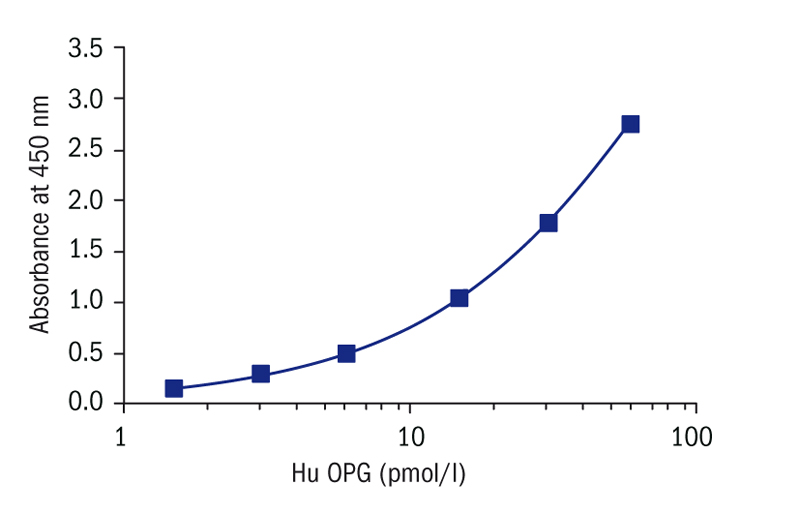Osteoprotegerin Human ELISA | RD194003200
- SKU:
- RD194003200
- Availability:
- In Stock
- Regulatory status:
- RUO
- Type:
- Sandwich ELISA, Biotin-labelled antibody
- Other names:
- OPG, Osteoclastogenesis inhibitory factor, OCIF, TNFRSF11B, Tumor Necrosis Factor Receptor Superfamily Member 11B
- Species:
- Human
- Size:
- 96 wells (1 kit)
Description
Osteoprotegerin Human ELISA | RD194003200
Features
- European Union: for in vitro diagnostic use
- Rest of the world: for research use only!
- The total assay time is less than 3.5 hours
- The kit measures osteoprotegerin in serum and plasma (EDTA, citrate, heparin)
- Assay format is 96 wells
- Quality Controls are human serum based
- Standard is recombinant protein based
- Components of the kit are provided ready to use, concentrated or lyophilized
Research topic
Bone and cartilage metabolism
Summary
Osteoprotegerin (OPG, osteoclastogenesis inhibitory factor, OCIF) is a product of
the TNFRSF11B gene, located on chromosome 8q24. OPG belongs to the TNF (tumor
necrosis factor receptor) superfamily, that plays a key role in bone remodeling. Human OPG
is a secreted glycoprotein composed of 401 aminoacid residues. OPG exists as a disulfidelinked
homodimer (120 kDa) or as a monomer (60 kDa). Both of these forms are active but
the dimer is more bioactive than the monomer. In contrast to most members of the TNF
receptor superfamily, OPG probably exists only in a soluble form. Its ligands are RANKL and
TRAIL. Human OPG shares 85% aminoacid identity to mouse OPG and 86 % identity to rat
OPG. In adult humans OPG mRNA is highly expressed in bones (osteblasts), endothelial
vessel cells, skin, liver, stomach, intestine, heart, brain and lung and is also present
in atherosclerotic plaques.
OPG and RANKL are involved in bone resorption and bone formation. OPG and receptor
RANK compete with each other for binding to the ligand RANKL. Binding of RANKL to RANK
stimulates osteoclasts and their activity. When RANKL binds to OPG, osteoclastogenesis
decreases. OPG prevents the formation of RANKL/RANK, inhibits formation of osteoclasts
and suppress bone resorption.
At normal physiological conditions OPG and ligand RANKL are in balance and bone resorption
and bone formation are linked. This balance can be disrupted by the lack of estrogens
in menopausal women, by anti-inflammatory effect of cytokines and by changes in the level
of glucocorticoids, thyroid hormones, parathyroid hormone or calcitriol. Any modification
in the RANKL/OPG ratio can induce either excessive bone resorption or, in contrast, excessive
bone formation. This disregulation can lead to pathological conditions such as
osteoporosis/osteopenia, bone tumor associated osteolysis, or cardiovascular pathology.
In postmenopausal osteoporosis, OPG serum level decreases and this decrease can be
an indicator of a higher risk for bones fracture. In patients with glucocorticoid induced
osteoporosis the RANKL/OPG ratio was higher. In patients with chronic obstructive pulmonary
disease with low bone mineral density (BMD), RANKL/OPG ratio was significantly higher
compared to those with normal BMD.
Patients with juvenile idiopathic arthritis had significantly lower levels of OPG in serum
and lower OPG/RANKL ratio.
The OPG/RANKL/RANK system affects the cardiovascular system as well. In patients with
ischemic heart disease the serum concentration of OPG was higher than that of healthy
people. In patients with high OPG the risk of cardiovascular mortality is three- or four-times
higher than it is in the healthy population.
Finally, the presence of malignant tumors leads to an inhibition of OPG production resulting
in high bone resorption.
The OPG/RANKL/RANK system affects bone loss in many pathological states and participates
in pathogenesis of vascular diseases. Determination of OPG concentration or RANKL/OPG
ratio is a clinical indicator in the diagnosis of the pathological states mentioned below.
Clinical use and areas of investigation:
Postmenopausal and glucocorticoid induced osteoporosis, Reumatoid arthritis, juvenile idiopathic arthritis, Ischemic heart disease, Diseases with changed bone resorption activity
Type
Sandwich ELISA, Biotin-labelled antibody
Applications
Serum, Plasma-EDTA, Plasma-Heparin, Plasma-Citrate
Sample Requirements
35 µl/well
Shipping
At ambient temperature. Upon receipt, store the product at the temperature recommended below.
Storage/Expiration
Store the kit at 2–8°C. Under these conditions, the kit is stable until the expiration date (see label on the box).
Calibration Curve
Calibration Range
1.5–60 pmol/l
Limit of Detection
0.03 pmol/l
Intra-assay (Within-Run)
n = 8; CV = 3.5%
Inter-assay (Run-to-Run)
n = 3; CV = 5.8%
Spiking Recovery
106,70%
Dilution Linearity
107,60%
Crossreactivity
- bovine Non-detectable
- cat Non-detectable
- dog Non-detectable
- goat Non-detectable
- hamster Non-detectable
- horse Non-detectable
- mouse Non-detectable
- pig Non-detectable
- rabbit Non-detectable
- rat Non-detectable
- sheep Non-detectable
- chicken Not tested
- human Yes
- monkey Yes (recommended dilution 1:3)







